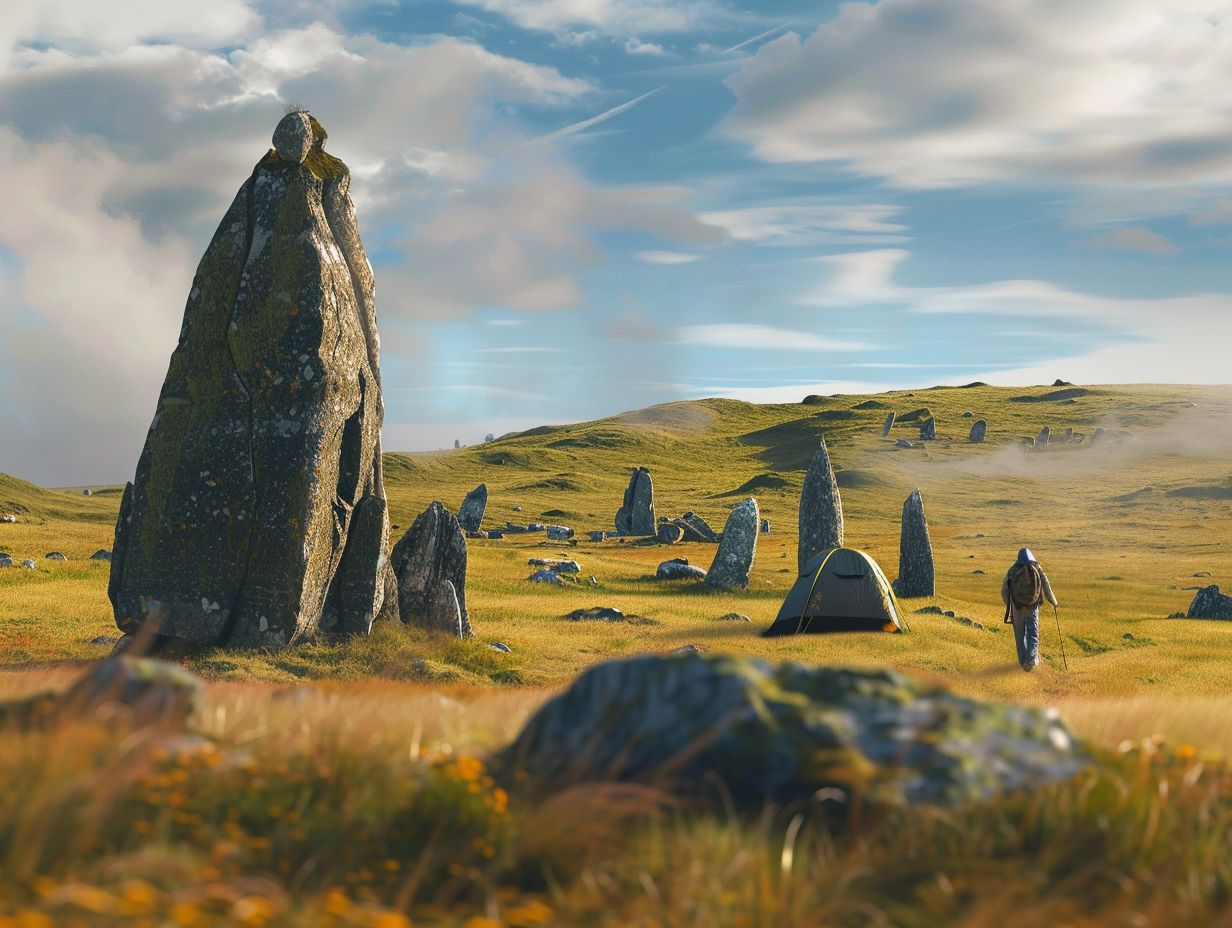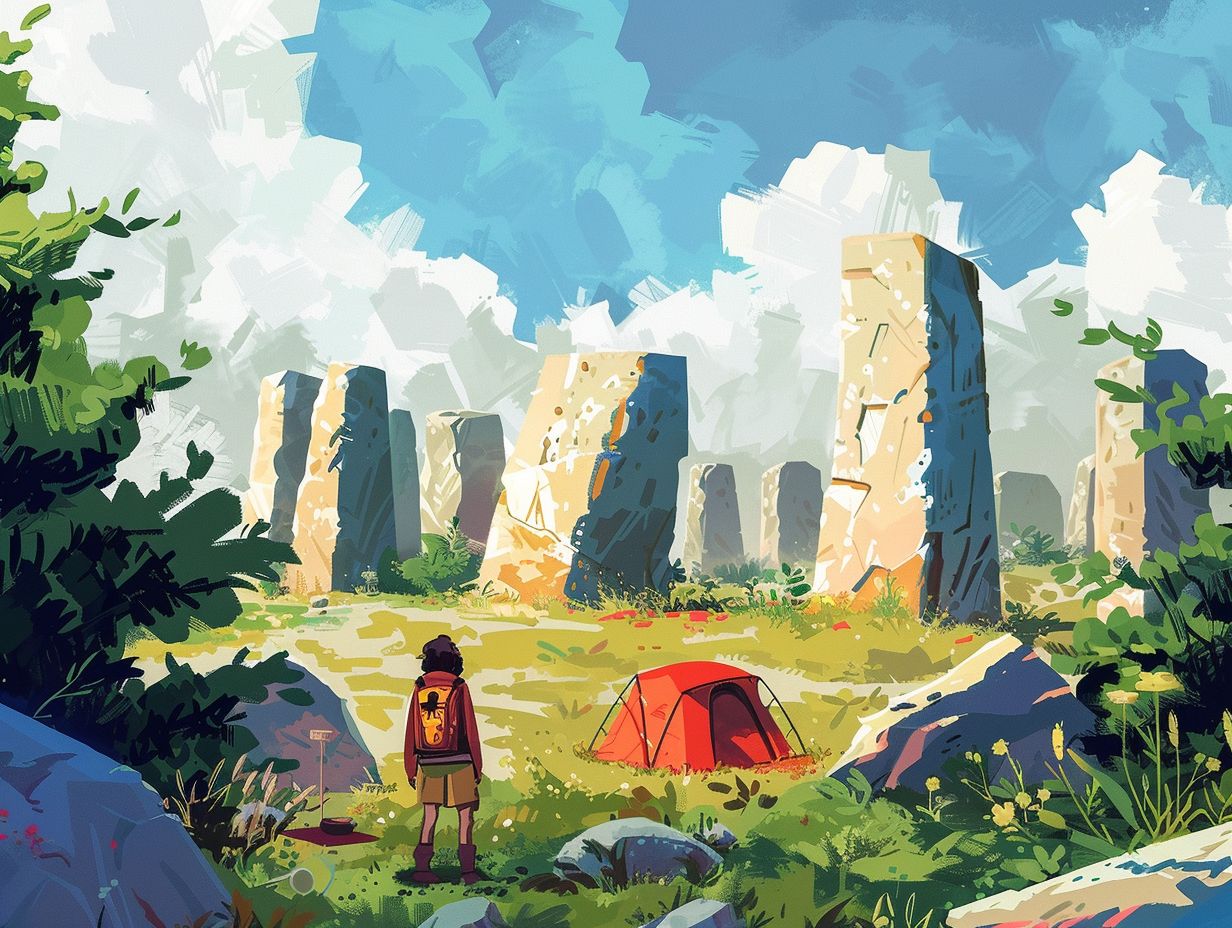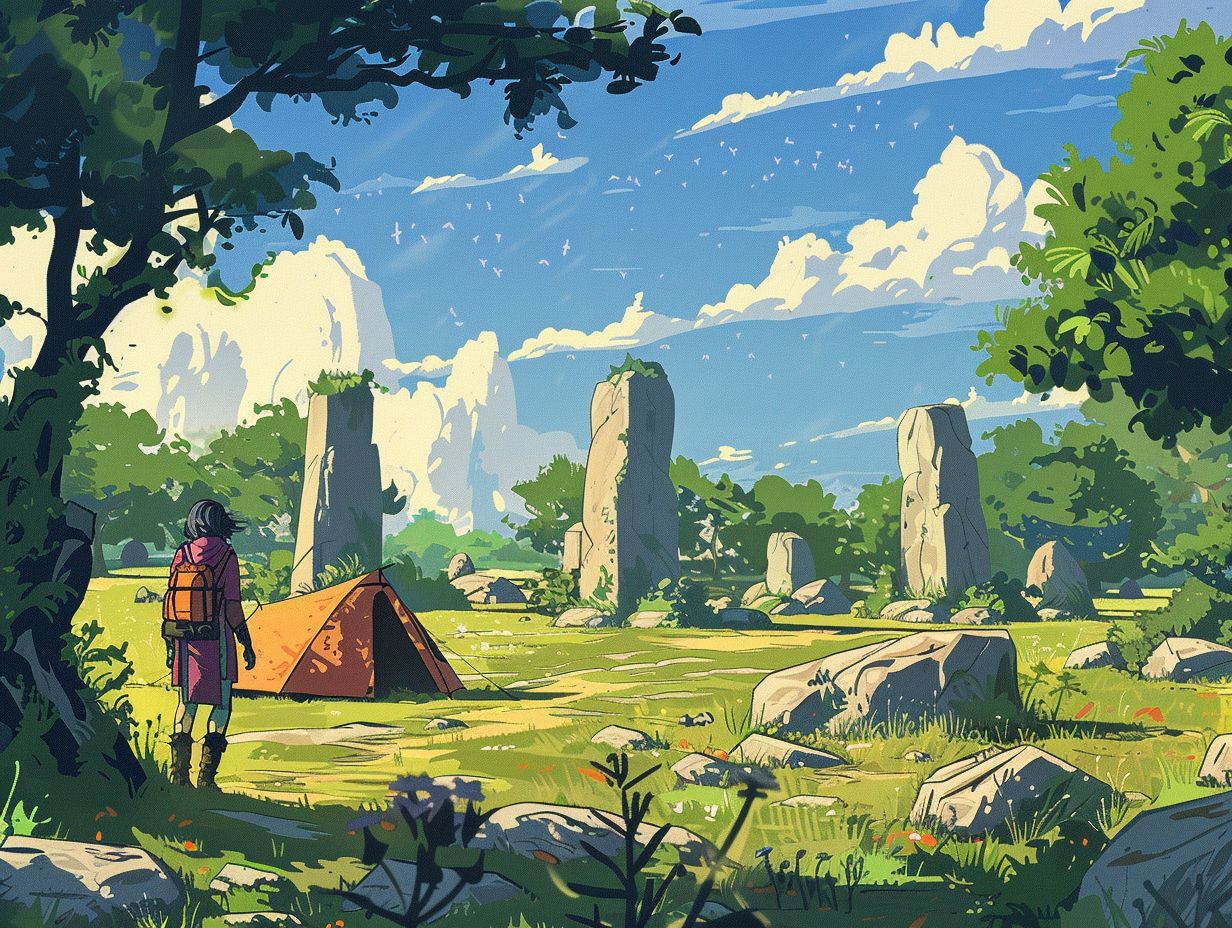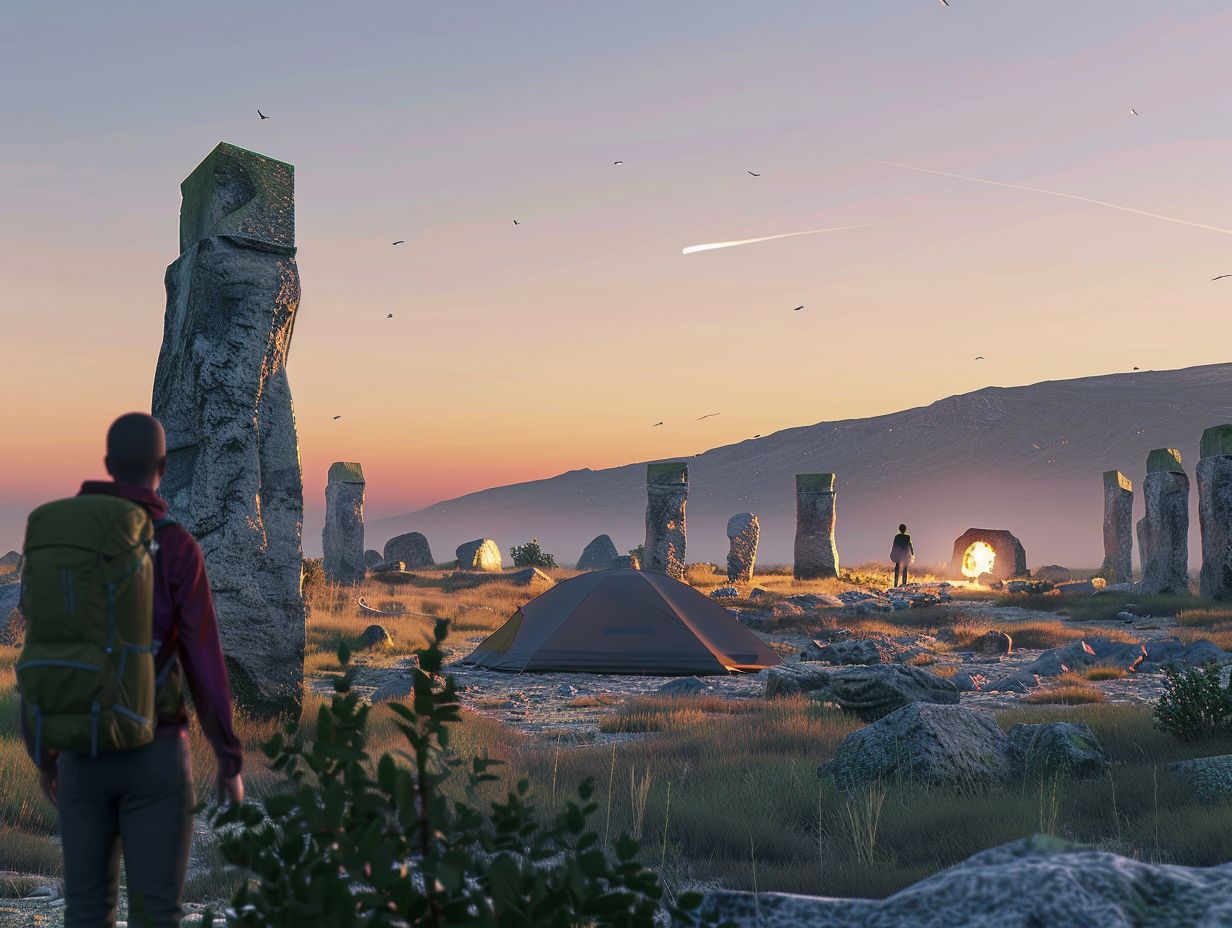The UK is renowned for its wealth of Neolithic sites, providing a captivating insight into ancient history. From Stonehenge to Skara Brae, these sites are imbued with profound cultural and historical importance.
This article aims to elucidate the means by which one can unearth these hidden treasures near UK campsites. Whether you possess a keen interest in history or are merely intrigued by the past, this exploration will guide you through the tools, methods, and protocols for experiencing these ancient marvels.
Be ready to venture into the neighbouring areas and unveil other historical and cultural landmarks that are eagerly awaiting exploration.
Key Takeaways:

- Discover the rich history of the UK by visiting Neolithic sites near campsites.
- Research and plan your trip to maximise your chances of finding Neolithic sites.
- Experience the significance of these sites and follow guidelines to respectfully interact with them.
What are Neolithic Sites?
Neolithic sites are ancient archaeological locations dating back to the Stone Age period, providing valuable insights into prehistoric human civilisation. These sites are of immense historical importance as they offer a glimpse into the early advancements and lifestyles of ancient communities.
One of the most well-known Neolithic sites, Stonehenge in England, continues to intrigue researchers and visitors with its mysterious formation and alignment with celestial events.
Similarly, Skara Brae in Scotland showcases the remarkable stone-built dwellings of Neolithic people. These sites not only exhibit architectural ingenuity but also illuminate the social structure, beliefs, and daily activities of our ancestors.
Neolithic Sites in the UK
Neolithic sites in the UK are well-known for their ancient monuments and archaeological significance, exemplified by iconic locations such as Stonehenge and Skara Brae that highlight the extensive history of prehistoric settlements.
Overview of Neolithic Sites in the UK
The Neolithic sites in the UK, such as Stonehenge and Skara Brae, offer you a unique window into the ancient past. These locations shed light on the development of human civilisation and the innovative architectural and cultural achievements of early societies.
Dating back to the Stone Age, a time marked by advancements in agriculture and the shift towards settled communities, these sites hold archaeological treasures that provide crucial insights into the daily routines, rituals, and beliefs of our forebears.
Stonehenge, with its famous stone circle, remains a source of fascination for both researchers and visitors, showcasing the cleverness and engineering skills of ancient civilisations. Similarly, Skara Brae in Scotland is celebrated for its remarkably well-preserved Neolithic village. This site exhibits impressive stone-built homes and a sophisticated grasp of urban planning for its era.
How to Discover Neolithic Sites Near UK Campsites
Exploring Neolithic sites near UK campsites can provide you with a captivating journey into history. This opportunity offers unique chances to investigate ancient monuments and archaeological landmarks that enhance your camping experience by providing cultural and historical insights.
Researching and Planning Your Trip

Before embarking on your Neolithic adventure near UK campsites, thorough research and planning are essential for identifying key archaeological sites, excavation areas, and historical landmarks to ensure a comprehensive exploration experience.
It is crucial to consider the proximity of campsites to significant ancient sites like Stonehenge or Hadrian’s Wall to maximise your exploration time. Familiarise yourself with the local regulations and guidelines for visiting these sites, as some may have restricted access or require special permissions.
Make sure to pack essentials such as sturdy footwear, maps, and a first aid kit to ensure your safety during excursions to remote Neolithic locations. Preparing for various weather conditions and staying informed about the history and significance of each site will enrich your journey.
Tools and Techniques for Finding Sites
By utilising modern tools and archaeological techniques, you can significantly enhance the exploration and discovery of Neolithic sites.
These methods enable visitors like yourself to uncover hidden monuments, unearth ancient artefacts, and contribute to the preservation of historical legacies.
The advanced tools and techniques play a crucial role in pinpointing significant Neolithic sites such as Stonehenge and Skara Brae, allowing researchers to delve deeper into the mysteries of ancient civilisations.
Ground-penetrating radar, LiDAR technology, and drones are just a few examples of the cutting-edge tools used to survey landscapes and reveal buried structures without disturbing the sites.
Excavation techniques like stratigraphy and carbon dating aid in accurately dating artefacts and reconstructing the past. Through these means, archaeologists can piece together the puzzle of the past and shed light on the daily life and rituals of our ancestors.
What to Expect at Neolithic Sites
Exploring Neolithic sites provides you with a captivating journey through time, allowing you to marvel at ancient monuments, uncover important archaeological findings, and delve into the enigmas of prehistoric civilizations.
Types of Sites and Their Significance
Neolithic sites encompass various types of locations, including burial mounds, Stone Age campsites, and ancient settlements, each holding significant cultural and historical importance in understanding the lifestyles and practices of early human societies.
Burial mounds, for example, provide valuable insights into ancient burial rituals and societal beliefs. These mounds, made of earth or stones, often contain human remains along with artefacts, offering clues to prehistoric customs and spiritual practices.
Stone Age campsites, on the other hand, reveal details about early human habitation patterns and daily life activities. The layout of these campsites can indicate social structures and resource management strategies employed by our ancestors.
Ancient settlements like Stonehenge or Skara Brae demonstrate architectural achievements and community organization in prehistoric times.
Guidelines for Visiting and Interacting with Sites
When visiting Neolithic sites, it is imperative that you show respect for the historical importance of these locations, adhere to conservation guidelines, and interact with the sites responsibly to ensure their protection and preservation for future generations.
One of the crucial elements of exploring these archaeological landmarks, such as Stonehenge or Skara Brae, is to acknowledge the enigmas and ancient findings they possess. By walking cautiously and refraining from touching or disrupting the structures, visitors can contribute to maintaining the authenticity and completeness of these sites.
Gaining knowledge about the history surrounding these Neolithic marvels provides a deeper insight and connection to the past, cultivating a sense of admiration and reverence for the individuals who constructed them.
Other Activities and Attractions Near Neolithic Sites

Exploring the areas surrounding Neolithic sites provides you with a wide range of activities and attractions. These include historical landmarks, cultural sites, natural wonders, and local heritage experiences, all of which enhance your overall visit to these ancient locations.
Exploring the Surrounding Area
Exploring the surrounding areas of Neolithic sites, such as the Lake District, presents you with the chance to discover awe-inspiring landscapes, explore ancient stone circles, and immerse yourself in the natural beauty and historical significance of the region.
The Lake District, characterised by its tranquil lakes, verdant valleys, and majestic mountains, serves as a magnificent setting for these historic sites.
Destinations like Castlerigg Stone Circle and Gamelands Stone Circle not only demonstrate the intelligence of our ancestors but also offer visitors insights into the spiritual and cultural traditions of bygone eras.
The enigmatic atmosphere that envelops these stone circles adds a sense of mystery to every visit, rendering them truly captivating cultural landmarks.
Additional Historical and Cultural Sites to Visit
Plus Neolithic sites, you have numerous historical and cultural landmarks to explore, providing valuable insights into the diverse heritage of the region and presenting a rich tapestry of historical narratives that complement your Neolithic experience.
These cultural landmarks encompass the iconic Castlerigg Stone Circle, a prehistoric monument with a fascinating history that attracts visitors seeking a deeper connection to the past. The Gamelands Stone Circle serves as evidence of ancient civilizations and their architectural capabilities.
By exploring these archaeological sites, you not only gain a glimpse into the Neolithic era but also uncover the layers of cultural significance woven into the history of the region.
Frequently Asked Questions
What are Neolithic sites?
Neolithic sites are ancient, prehistoric settlements dating back to the Stone Age, between 10,000 BC to 2,000 BC.
How can I discover Neolithic sites near UK campsites?

You can discover Neolithic sites near UK campsites by researching and visiting various historical and archaeological sites in the area, or by joining guided tours or hikes.
What are some famous Neolithic sites near UK campsites?
Some famous Neolithic sites near UK campsites include Stonehenge, Avebury Stone Circle, and Skara Brae.
Why should I visit Neolithic sites near UK campsites?
Visiting Neolithic sites near UK campsites allows you to experience and learn about ancient cultures and civilizations, as well as appreciate the rich history of the area.
Are there any regulations or restrictions for visiting Neolithic sites near UK campsites?
Yes, there may be regulations and restrictions in place for visiting Neolithic sites, such as no camping or littering on the sites, and following designated paths and routes.
Can I camp near Neolithic sites in the UK?
It depends on the specific site and its regulations. Some Neolithic sites may have designated camping areas, while others may not allow camping at all. It’s best to research and plan ahead before camping near Neolithic sites in the UK.



